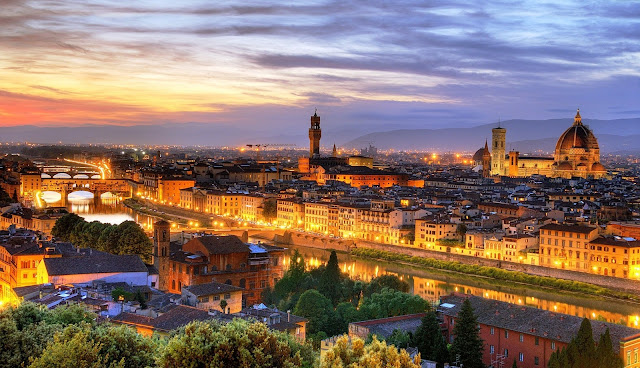 |
| Florence, Italy, today--Jerusalem's rival as the "City of David." |
The great cities of the world each have within them a great work of art that, through civic pride, or sometimes largely by accident, have come to be seen as symbols of that city. New York has its Empire State Building, London its Tower of Big Ben, Paris its Eiffel Tower, Washington it's Capitol, Orlando has Cinderella's Castle, Cairo its pyramids, San Francisco its Golden Gate Bridge, Rome its Coliseum, and Moscow its Cathedral of St. Basil. All of these monuments to artistic expression were, however, created for other than symbolic purposes. In 1501, the city of Florence needed a symbol. It had been suffering for some years something of an identity crisis, unsure whether it wanted to be a republic or an oligarchy, buffeted internally by Machiavellian politics on the one hand and righteous Savonarola outrage on the other. The ruling family, the de Medici had been overthrown and banished, followed by a republican form of government reinstalled, temporarily at least.
 |
| Michelangelo's Florence, 1493 |
 |
| David, 1430, Donatello |
For as long as anyone could remember, the city had always identified with the heroic figure of David from the Old Testament, idealizing themselves (with some justification) as giant killers. Donatello had cast a David (right) in bronze in 1430, the first fully nude sculptural figure since antiquity. It wasn't very heroic though. It was the life-size figure of a sensuous, adolescent boy wearing a slightly outlandish hat, very closely aligned with scripture perhaps, but not a very impressive civic icon. Verrocchio had made another life-size figure of David (below, left), about 1476, somewhat more idealistic, but bearing something of a teenage "smart-ass" look at having bested a superior force in slaying Goliath, whose head lies at his feet. Not only was this figure not quite the look a proud city could be proud of, worse than that, it was a Medici creation. They turned to a longtime favorite son for something better--a giant killer of gigantic proportions himself--a monumental David.
 |
| David, 1473-75, Verrocchio |
The city fathers of Florence didn't have much to offer the upstart rising star of the new century. The brash, young sculptor, Michelangelo Buonarroti, was 26 and of a mind that he could do anything. Carve a David? Sure, how many you want of'em? Originally the figure was planned for the a buttress of the cathedral, high above the ground. (Later it's location was changed to the square in front of the town hall.) The money was downright insulting and the marble was an old twelve-foot hunk of stone another sculptor had hacked away at some twenty years before. Once the monolith was raised from the weeds out back of the cathedral and carted gingerly to a warehouse where Michelangelo could work on it, he saw the problem was worse than he'd thought. The stone was too shallow. Some twelve feet in height, the irregularly shaped marble was, in some places, barely 18 inches deep. Undeterred, Michelangelo borrowed a friend and posed him nude, started sketching, did some measurements, and pronounced the project doable--though barely (no pun intended). It occupied him for most of three years, reportedly some of the happiest of his working life.
 |
| David (detail), 1501-04, Michelangelo |
The result was a supremely classical figure, at least until one's gaze lifted to the face of Michelangelo's giant with it's determined gaze and youthfully, heroic spirit unlike anything Greek or Roman. It was Florentine. It announced to the world that Florence the city, and Michelangelo the artist, were powerful forces to be reckoned with in the future.
 |
| The third copy, David in bronze, Piazza Michelangelo, Florence, Italy. Other works by the sculptor adorn the base. |

No comments:
Post a Comment